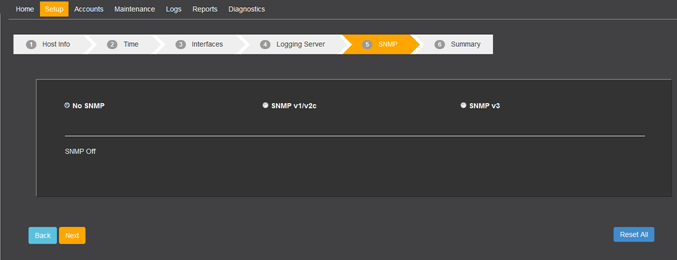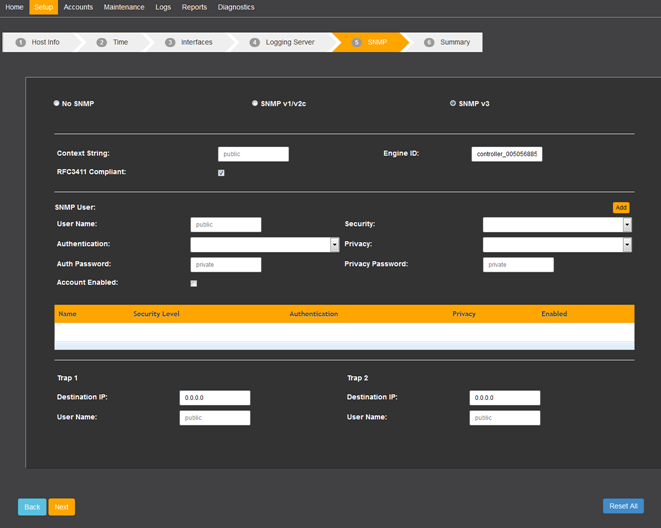SNMP
To access the SNMP Setup screen, click Setup, and then click the SNMP tab. The SNMP Setup screen appears (see the following figures).
On this screen you can enable/disable SNMP and set up SNMPv2/v3 with
correct parameters (for connecting to NMS/EMS hardware—for example, NetSight—to which
OneController sends its status information and events).

Note
This is independent of the SNMP module that runs as part of the OneController software that can be used to send configuration information to switches.To disable SNMP, click No SNMP.
SNMP Setup Screen—SNMP Disabled

To enable SNMPv1 or v2c, click SNMPv1/v2c, and enter
values in the following boxes:
SNMP Setup Screen—SNMPv1/v2c

| Read Community | The read community string. |
| Write Community | The write community string. |
| Manager A | IP address of Manager A. |
| Manager B | IP address of Manager B. |
To enable SNMPv3, click SNMPv3, and enter values in the following
boxes:
SNMP Setup Screen—SNMPv3

| Context String | An SNMP context is a collection of management-related information. The SNMP context is identified by the combination of Engine ID and a context string. The context string can be a maximum of 32 octets (ASCII characters) long. |
| Engine ID | The Engine ID uniquely identifies the SNMP engine instance (SNMP agent on the OneController). The Engine ID is used in conjunction with SNMP user passphrases to generate the keys that are used to secure SNMP transmissions for the user. |
| RFC3411 Compliant | When enabled, the OneController prefixes the administrator-entered Engine ID string with 4 octets representing the "binary equivalent of the agent‘s SNMP management private enterprise number as assigned by the Internet Assigned Numbers Authority (IANA)” according to RFC3411. Otherwise, the Engine ID entered by the administrator is used as is. |
| SNMP User | |
| User Name | The unique identifier for an account that can send SNMPv3 messages to and from the controller. |
| Security | The SNMPv3 security level of the user account. An
account must have one of three security levels:
|
| Authentication | Sets the algorithm used to generate signatures for
authentication:
|
| Privacy | Sets the algorithm used to encrypt messages:
|
| Auth Password | Passphrase that SNMP uses to generate the key used to generate signatures for messages. |
| Privacy Password | Passphrase that SNMP uses to generate the key used to encrypt/decrypt messages. |
| Account Enabled | Enables/disables the ability to send and receive messages for this account. |
| Trap 1 OneController allows you to define up to two different network managers that can receive SNMP notifications (traps). Each trap destination is defined by an IP address and user name: | |
| Destination IP | For trap 1, the IP address where traps are forwarded to. |
| User Name | Account name used when sending traps to the destination IP address. The user name must correspond to one of the SNMP v3 users listed in the account table. Traps are sent using security level settings defined for the selected account. Each trap destination can use a different SNMPv3 user account for transmission. |
| Trap 2 OneController allows you to define up to two different network managers that can receive SNMP notifications (traps). Each trap destination is defined by an IP address and user name: | |
| Destination IP | For trap 2, the IP address where traps are forwarded to. |
| User Name | Account name used when sending traps to the destination IP address. The user name must correspond to one of the SNMP v3 users listed in the account table. Traps are sent using security level settings defined for the selected account. Each trap destination can use a different SNMPv3 user account for transmission. |
 Print
this page
Print
this page Email this topic
Email this topic Feedback
Feedback